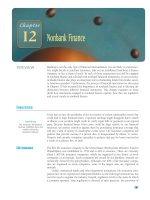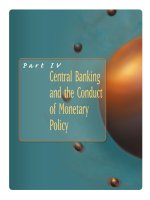oil and financial markets deutsche bank (2011)
Bạn đang xem bản rút gọn của tài liệu. Xem và tải ngay bản đầy đủ của tài liệu tại đây (1021.86 KB, 26 trang )
Deutsche Bank AG
Oil & Financial Markets
2011 EIA Energy Conference
26-April-2011
Adam Sieminski, Chief Energy Economist
Commodities Research
USA +1 202 662 1624
Deutsche Bank AG
All prices are those current at the end of the previous trading session unless otherwise indicated. Prices are sourced from local exchanges via
Reuters, Bloomberg and other vendors. Data is sourced from Deutsche Bank and subject companies. DISCLOSURES AND ANALYST
CERTIFICATIONS ARE LOCATED IN APPENDIX 1.
Adam Sieminski +1 202 662 1624 April 26, 2011
Deutsche Bank
2
Transportation
Refining
Storage
Distribution
Consumption
Production
Exploration
Banks play a role across the entire product cycle
Source: Deutsche Bank
The Role of Banks in Oil Markets
Adam Sieminski +1 202 662 1624 April 26, 2011
Deutsche Bank
The Role of Banks in Oil Markets
3
Energy companies
face constrained
operating cash
flows which inhibit
flexibility to make
investments and
effectively hedge
risks
Balance sheets of many
energy producers are
constrained and do not
offer excess free
liquidity
Many energy companies do not have high
credit ratings, resulting in greater borrowing
costs to access the capital markets
Business models are capital intensive with
significant investment required for projects such
as exploration, production, transportation etc.
Some energy markets
are illiquid (especially
for bespoke products)
and require hedging to
protect capital
investment
Banks with their liquid assets are therefore uniquely positioned to play a crucial role in
commodity markets, offering various liquidity and capital solutions
Banks play a crucial role providing liquidity and capital
Source: Deutsche Bank
Adam Sieminski +1 202 662 1624 April 26, 2011
Deutsche Bank
60
70
80
90
100
110
120
130
Jan-10
Mar-10
May-10
Jul-10
Sep-10
Nov-10
Jan-11
Mar-11
Brent
USD/bb l
Outlook
The first $15 leg up (from $80 to $95) coincided with the market starting to feel the pinch of the huge global demand increase that took
place in 2010. At the start of 2010, the consensus view was world demand would grow by 1.4mmb/d, and now the IEA estimates a
whopping 2.8mmb/d. World economic growth of 5%, coldest winter in 30 years, French oil labor strike, China coal halt at end-2010.
The second $15 leg came with the Q1 events in MENA. The Libya export interruption worth another 1.4mmb/d probably causing at
least half of the second leg (or maybe more) given that it is very low-sulfur crude in high demand for light products and hard to replace
(without some logistical changes) by Saudi spare capacity which is higher in sulfur content.
Steady near $80/bbl, then jumps to $95/bbl, followed by $115/bbl
4
Three Stage Increase in Brent Oil Prices ?
Source: Bloomberg Finance LP,
DB Global Markets Research
Oil demand impact
MENA impact
Exuberance ?
Adam Sieminski +1 202 662 1624 April 26, 2011
Deutsche Bank
What Is Volatility?
Chemistry: Evaporating readily.
Economics: Percent change in price over a given period.
Trading: Historical Volatility is the annualized standard
deviation of percent changes in futures prices over a given
period. Implied volatility from options market prices.
Politics: The price going in a direction you don't like
…usually reserved for UP rather than DOWN.
To Fly Away
Source: Deutsche Bank
5
“Oil and energy
price volatility is
poorly defined
with no accepted
conceptual frame
work for
analyzing or
interpreting it
…not to mention
designing
policies and
policy
instruments to
mitigate or
reduce
its effects.”
Ali Aissaoui
APICORP
personal communication
October 2009
used with permission
Adam Sieminski +1 202 662 1624 April 26, 2011
Deutsche Bank
Positive Aspects of Higher Oil Prices
More non-OPEC oil supply
Better economics of renewables and
alternative fuels
Demand efficiency
Higher prices may simply be providing the proper signals to the market
6
Source: Deutsche Bank
Adam Sieminski +1 202 662 1624 April 26, 2011
Deutsche Bank
A Primer On Oil Prices
Product prices determine crude oil prices and crude oil prices determine product prices.
Here are the things that really matter:
A bidirectional system of causality
7
Volume and characteristics of alternative crude oil types offered for sale
(not all the same!)
Capability and capacity of the world refining industry to process these crudes
Government-mandated specifications for oil products marketed by refiners
Characteristics and volume of global petroleum demand
Available storage capacity for crude oil and petroleum products
Flexibility of the world transportation system for getting petroleum from the point of
production to the point of sale
Source: Philip Verleger, PKVerleger LLC, “A Primer on Oil Prices”, 2009 manuscript used with permission
Adam Sieminski +1 202 662 1624 April 26, 2011
Deutsche Bank
Oil Prices Relate To Many Uncertain Factors
Speculation, hedging,
investment
Global economic
growth
OPEC production
decisions
Exchange rates and
Inflation
Spare production
capacity
Global
Oil Prices
Non-OPEC supply
growth
Inventories
Geo-political risks
Weather
Volatility in oil prices is often attributed to events and uncertainties in the markets
Source: Richard Newell, EIA Administrator, US DOE, NASEO Winter Fuels Outlook, October 2009
8
Adam Sieminski +1 202 662 1624 April 26, 2011
Deutsche Bank
Current Assessments and Future Expectations
Market
Price
Willing Buyers &
Willing Sellers
Price formation in the oil sector is complicated by future expectations
Source: Dean Foreman, Chief Economist, Talisman Energy, personal communication, September 2009, used with permission
9
Supply
Current
Assessments
Future
Expectations
Demand
Inventory Levels
Capacity Utilization
Value After Refining
Current Market Level
Recent Market Direction
Weather
Geopolitics
Demand Growth
Supply Growth
Capacity Growth
Logistics Availability
Financial Markets
Interest Rates, Foreign
Exchange, Asset Markets
Adam Sieminski +1 202 662 1624 April 26, 2011
Deutsche Bank
0.0
0.5
1.0
1.5
2.0
2.5
3.0
3.5
4.0
4.5
Jan-08
Jul-08
Jan-09
Jul-09
Jan-10
Jul-10
Jan-11
Jul-11
Actual
Estimate
million b/d
Khurais (+1.2),
Nuayyim +0.1),
Shaybah (+0.25)
Libya (-1.4)
Demand increase
(-0.7)
Demand decrease
(+1.5)
Outlook
The low of about 1mmb/d was reached in Jul-2008 as Saudi Arabia production rose to 9.7mmb/d in an effort to quench the 2008 price
rise. The rise to 2.5mmb/d by Jan-2009 was a function of the drop in needed OPEC crude caused by the economic recession.
During 2009, Aramco completed three new upstream projects (Khurais, Nuayyim, and Shaybah), adding over 1.5mmb/d of capacity.
As the economy recovered an oil demand rose in 2010, the US DOE/EIA estimates that by early 2011 Saudi spare capacity was down
to about 3.15mmb/d (with Kuwait, Qatar, and the UAE accounting together for a bit less than 1mmb/d more).
Assuming that the Saudis make up 1.4mmb/d of the lost Libyan production, their spare capacity will be under 2mmb/d in May.
Currently 2mmb/d lower than it was last summer; still above the lows of summer 2008
Source: US DOE/EIA, OPEC Secretariat,
Deutsche Bank
10
Saudi Spare Capacity Is a Key Indicator
Adam Sieminski +1 202 662 1624 April 26, 2011
Deutsche Bank
Very low sulfur content of Libyan crude makes it nearly impossible to directly replace with Saudi
Source: ENI
11
Saudi Crude Is NOT a Substitute for Libyan Blend
LBY
Adam Sieminski +1 202 662 1624 April 26, 2011
Deutsche Bank
Inelastic Short-Term Supply and Demand
Peak Oil (Inelastic Supply)
Insatiable China (Inelastic Demand)
Demand is inelastic due to long lead times for altering the stock of fuel-consuming equipment; supply is inelastic in the short-run because it takes time
to augment the productive capacity of oil fields.
Price volatility provides incentives to hold inventories, but since inventories are costly, they are not sufficient to fully offset the rigidity of demand and
supply. This fact means that shocks to demand or to supply can help to explain the high level of volatility in oil prices.
Volatility is high because the underlying demand and supply curves are so inelastic
12
Source: James L. Smith, Southern Methodist University, “World Oil: Market or Mayhem?”, MIT/CEEPR, September 2008
0
1
2
3
4
5
6
7
8
9
1
2
3
4
5
6
Price
Quantity
S2
S1
Demand
0
1
2
3
4
5
6
7
8
9
1
2
3
4
5
6
Price
Quantity
D2
D1
Supply
Source: Deutsche Bank
Source: Deutsche Bank
Adam Sieminski +1 202 662 1624 April 26, 2011
Deutsche Bank
13
Income Elasticity of Demand is Strong
China
India
Brazil
US
UK
Canada
Sweden
Mexico
Russia
Thailand
Indonesia
Venezuela
Japan
Italy
Australia
France
Germany
South Korea
Taiwan
0.0
0.5
1.0
1.5
2.0
2.5
3.0
0 5 10 15 20 25 30 35 40 45 50
Oil consumption per capita (gallons per day)
GDP per capita ('000 USD)
Contributing to a view that demand is highly inelastic
Source: IMF, IEA, Deutsche Bank
Twenty five
years ago,
South Korea
and Taiwan
were where
China and
India are now.
One third of
the world’s
population is
just entering
the middle
class and want
the oil-
consuming
lifestyle that
goes with that.
Adam Sieminski +1 202 662 1624 April 26, 2011
Deutsche Bank
A Proliferation of Hubbert’s Peak Books!
“…doomsayers
hard at work
fanning the
flames of
hopelessness and
pessimism”
Leonardo Maugeri
“The Age of Oil”
Praeger, 2006
14
Hubbert’s Peak: The Impending World Oil Shortage
Kenneth Deffeyes, 2001-2003
The Party's Over: Oil, War and the Fate of Industrial Societies
Richard Heinberg, 2003-05
Out of Gas: The End of the Age Of Oil
David Goodstein, 2004
Twilight In the Desert: The Coming Saudi Oil Shock
Matthew Simmons, 2005
The End of Oil: On the Edge of a Perilous New World
Paul Roberts, 2005
Peak Everything: Waking Up to the Century of Declines
Richard Heinberg, 2007
Source: Deutsche Bank
Contributing to a view that supply is highly inelastic
Adam Sieminski +1 202 662 1624 April 26, 2011
Deutsche Bank
Inelastic Short-Term Supply and Demand
Oil markets are characterized by inelastic supply and demand (with respect to price)
15
Source: Deutsche Bank
0
0.2
0.4
0.6
0.8
1
1.2
1
2
3
4
5
6
Price
Quantity
Inelastic
Demand
Inelastic
Supply
Adam Sieminski +1 202 662 1624 April 26, 2011
Deutsche Bank
The Oil Under-Investment Cycle
Part of the volatility in oil prices is explained by investment cycles
As governments
(producer and
consumer) take
more control of
oil, supply is
constrained and
the under-
investment cycle
is exacerbated.
Paul Sankey
16
Paul Sankey, “The Peak Oil Market”, Deutsche Bank Securities, October 2009
blank
Adam Sieminski +1 202 662 1624 April 26, 2011
Deutsche Bank
Speculation Is NOT Manipulation
INVESTMENT: Placing funds with a conservative expectation of earning a return
through dividends more than appreciation.
HEDGING: A financial strategy designed to reduce risk from price changes by
taking a position in a futures market opposite to a position held in the cash market.
SPECULATION: Placing funds with the understanding that the deal entails high
risk. Speculators tend to rely mainly on price changes to generate profit.
GAMBLING: Risking money on an outcome that depends mostly on chance.
MANIPULATION: Deliberately misleading other investors to artificially inflate or
deflate market prices.
Source: Deutsche Bank
17
Fitting speculation into a scale of market activity
Adam Sieminski +1 202 662 1624 April 26, 2011
Deutsche Bank
Expert Opinion Can Change Rapidly and Significantly
Copyright: The Economist
Used with Permission
Copyright: The Economist
Used with Permission
March 1999 October 2003
18
Adam Sieminski +1 202 662 1624 April 26, 2011
Deutsche Bank
Did Speculators Drive Oil to $147/bbl in 2008?
Main Street blames Wall Street
Source: Deutsche Bank
Source: Deutsche Bank image library
19
Extraordinarily strong (unsustainable?) global economic growth
from 2002-2007.
Constrained oil supply from key producers like Russia, Venezuela,
Nigeria, Iran, Iraq and others.
Lack of OPEC spare production capacity and untimely cutbacks by
OPEC at the end of 2006 that were not reversed until late 2007.
Changes in oil product specifications (low sulfur fuels)
Lack of spare refining capacity to handle heavy sour crude oil.
Subsidies on oil consumption in many rapidly growing countries
(economy, population or both) in Asia and the Middle East.
Untimely strategic petroleum reserve purchases by both China and
the US in 2007 and 2008.
US dollar depreciation.
Why Don’t They Look Here?
Adam Sieminski +1 202 662 1624 April 26, 2011
Deutsche Bank
Headline Perception of Factor Weights
Blaming speculators generates great 30-second sound bites, but does it reflect reality?
20
Source: Deutsche Bank
Adam Sieminski +1 202 662 1624 April 26, 2011
Deutsche Bank
Where Does That Leave Us?
21
“Forcing passive investors out of the oil
derivative markets will reduce contango and
inventories, and ultimately push prices up.”
Philip Verleger, The Petroleum Economics Monthly, August 2009
Adam Sieminski +1 202 662 1624 April 26, 2011
Deutsche Bank
A Final Thought: Rare Events
Capacity to understand our world still has limits
Computer models work best with good data sets
Recent events loom large
Non-rational behavior is commonplace
Accidents happen
Some events are random
Explaining occurrences that have seemingly low probabilities
22
Source: Jonathan Adelman, University of Denver,
Private lecture in Los Angeles, September 2009, used with permission
Adam Sieminski +1 202 662 1624 April 26, 2011
Deutsche Bank
Adam Sieminski
Adam is the Chief Energy Economist for Deutsche Bank, working
with the Bank's global commodities research and trading units.
Drawing on extensive industry, government and academic sources,
Mr. Sieminski forecasts energy market trends and writes on a variety
of topics involving energy economics, climate change, politics and
commodity prices. From 1998 to 2005 he served as the energy
strategist for Deutsche Bank's global oil & gas equity team. Mr.
Sieminski was the senior energy analyst for NatWest Securities in
the US during 1988-1997, covering the major US international
integrated oil companies. He received both his undergraduate
degree in Civil Engineering and a masters in Public Administration
from Cornell University.
He has been president of the US Association for Energy Economics
and the National Association of Petroleum Investment Analysts. He
is a member of the US National Petroleum Council, an advisory
group appointed by the US Secretary of Energy. He also acts as a
senior advisor for the Center for Strategic and International Studies,
a nonpartisan policy think-tank in Washington. He is a member of
the London, New York and Washington investment professional
societies, and holds the Chartered Financial Analyst (CFA)
designation.
23
Adam Sieminski +1 202 662 1624 April 26, 2011
Deutsche Bank
24
The views expressed in this report accurately reflect the personal views of the undersigned lead analyst. In addition, the
undersigned lead analyst has not and will not receive any compensation for providing a specific recommendation or view in
this report.
Adam Sieminski
Appendix 1: Analyst Certification
Adam Sieminski +1 202 662 1624 April 26, 2011
Deutsche Bank
25
Australia: This research, and any access to it, is intended only for "wholesale clients" within the meaning of the Australian
Corporations Act.
EU countries: Disclosures relating to our obligations under MiFiD can be found at
/>Japan: Disclosures under the Financial Instruments and Exchange Law: Company name - Deutsche Securities Inc.
Registration number - Registered as a financial instruments dealer by the Head of the Kanto Local Finance Bureau (Kinsho)
No. 117. Member of associations: JSDA, The Financial Futures Association of Japan. Commissions and risks involved in
stock transactions - for stock transactions, we charge stock commissions and consumption tax by multiplying the transaction
amount by the commission rate agreed with each customer. Stock transactions can lead to losses as a result of share price
fluctuations and other factors. Transactions in foreign stocks can lead to additional losses stemming from foreign exchange
fluctuations.
New Zealand: This research is not intended for, and should not be given to, "members of the public" within the meaning of
the New Zealand Securities Market Act 1988.
Russia: This information, interpretation and opinions submitted herein are not in the context of, and do not constitute, any
appraisal or evaluation activity requiring a license in the Russian Federation.
Appendix 1: Country-Specific Disclosures









